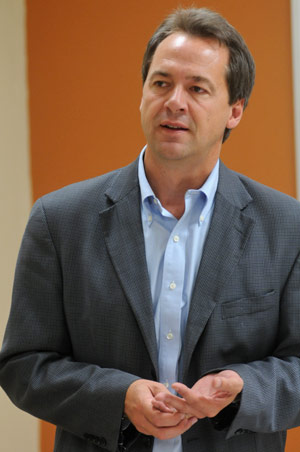When it comes to Montana’s energy landscape, development and resources are as diverse as the state’s physical landscape, with coal, natural gas, hydroelectric and wind power plants dotting the map.
With the Bakken oil boom revving up the economies in eastern Montana and potential federal coal regulations on the radar, the state’s energy future depends on a long-term vision, Gov. Steve Bullock said, with an eye on keeping Montana’s energy profile diverse.
Bullock, a Democrat who took office at the beginning of the year, said in an interview with the Beacon that he hopes to shepherd the state toward a future that focuses on clean and affordable energy development, while acknowledging that there will continue to be a need for fossil fuel production.
“Montana has incredible opportunities, if done right,” Bullock said. “It’s easy to get completely tied up in the conflicts of the moment, but we need to be looking long term, and that’s long term for our renewable development opportunities, and long term in ways that we recognize that coal will be part of our energy future.”
The governor’s statements come on the heels of the U.S. Environmental Protection Agency’s recently proposed regulations on carbon emissions for new coal-powered plants, which would limit emissions to 500 kilograms per megawatt hour.
The U.S. Energy Information Administration states that Montana held one-quarter of the estimated recoverable reserve base of coal in the United States at the end of 2010, and was the sixth largest coal-producing state in 2011.
With that much coal in the ground, Bullock said production will likely be part of the state’s energy future, but current market conditions are hampering new plants.
“One of the reasons why new plants aren’t being built is that the market has changed substantially and natural gas is so affordable,” Bullock said.
The state is looking at the EPA’s new potential regulations with care, he said.
“I don’t want to set us up for failure, setting a bar for regulations that could never be met,” Bullock said. “We need to be making substantial investments in coal technology, because coal will be part of the (overall energy picture).”
Bullock said the proposed Otter Creek Coal Mine in southeastern Montana could result in $200 million in tax revenue each year, and his administration will look carefully at the cost of leaving that coal in the ground versus mining it.
“We need to make sure we’re not giving our resources away, more or less,” he said.
Challenges to the coal industry on the basis of carbon emissions are easy for opponents to make, Bullock said, just like it’s easy for critics to dismiss renewable energy based on arguments about consistency or lack of a modern grid for transmission.
For both situations, the solutions lie in the future, the governor said. In order to ensure Montana takes a long-term view on energy production, Bullock said there needs to be an effort to retain Montana’s students and promote energy research at state universities.
 |
|
Montana Governor Steve Bullock – File photo by Lido Vizzutti | Flathead Beacon |
In June, the Western Governor’s Association released its 10-year energy plan, as well as a collection of perspectives from western governors regarding their respective states’ energy potential and challenges.
Bullock said he is by and large on board with the WGA’s general energy goals, some of which include putting the United States on a path to energy security. The goals also seek to ensure energy is clean, affordable and reliable through a balanced portfolio of renewable, non-traditional and traditional resources; and establish an energy distribution infrastructure planning, siting and permitting system that facilitates development of necessary infrastructure while maintaining natural resource and environmental protection.
Clarifying the permitting process will be one of Bullock’s focuses when it comes to energy development, he said, and by doing so, will make the state more attractive to businesses.
“That’s not gutting the permit process and that’s not making it easier, but it’s everybody coming in and singing off the same song page of what they ought to expect,” Bullock said.
Another major issue in Montana’s energy profile – fracking as a part of oil shale development – is on Bullock’s radar as well. When it comes to fracking, Bullock said he believes the state is competent at monitoring and regulating the various projects throughout the state.
There cannot be a one-size-fits-all approach to such regulations, he said, which is also what he wrote in August to U.S. Secretary of the Interior Sally Jewell regarding proposed federal fracking regulations. Bullock wrote that Montana has a productive working relationship with the Bureau of Land Management in regards to fracking, and most of the proposed federal rules would be “redundant” here.
That means fracking projects need to be looked at on a case-by-case basis, he said in an interview.
“There are areas that we certainly need to protect,” Bullock said, adding that he supports Montana Congressman Steve Daines and Sen. Max Baucus’ bills to protect the North Fork of the Flathead from oil and gas exploration or development.
Overall, the governor believes there is great potential in Montana’s energy future, and that by maintaining a realistic approach to fossil fuel and renewable resource development, the state’s energy economy can flourish.
“What we know today is going to be eclipsed by tomorrow, and we need to make sure we’re pushing that along,” Bullock said.